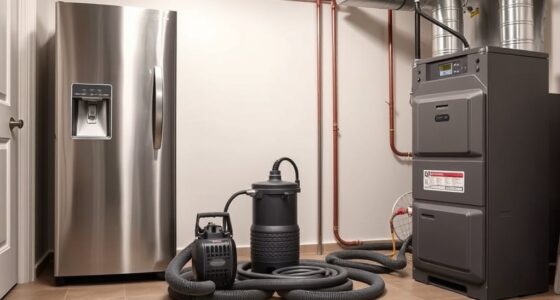To store fuel safely for emergencies, choose durable, approved containers made from high-quality materials like polyethylene or metal, and label them clearly. Follow local regulations, keep fuels in cool, ventilated areas away from heat, and avoid overfilling to prevent spills. Proper handling includes regular inspections and using spill kits. If you want to know how to maintain, transport, and dispose of fuels properly, keep exploring for essential safety tips.
Key Takeaways
- Use high-quality, approved containers made from polyethylene or metal with secure caps and venting features for safe fuel storage.
- Store fuels in a cool, dry, well-ventilated area away from heat sources, ignition points, and direct sunlight.
- Label containers clearly (e.g., “Gasoline,” “Diesel,” “Propane”) and conduct regular inspections for leaks or damage.
- Follow local regulations regarding fuel storage permits, area restrictions, and safety guidelines to ensure compliance.
- Keep spill response kits accessible, and develop emergency plans for safe handling, spill cleanup, and fuel disposal during emergencies.
Choosing the Right Storage Containers for Fuel

When selecting storage containers for fuel, it is vital to prioritize safety and durability. You need containers that maintain fuel stability over time, preventing leaks or degradation. Look for options made from high-quality materials like polyethylene or metal, which resist corrosion and physical damage. Container durability ensures your fuel stays secure and uncontaminated during storage. Properly designed containers also feature secure caps and vents to prevent pressure buildup and spills. Avoid cheap or flimsy options that may crack or degrade quickly. Choosing robust, well-constructed containers helps keep your fuel safe, reduces risks of leaks, and maintains fuel quality. Investing in durable, safety-tested containers ensures your emergency fuel supply remains reliable and secure when you need it most. Additionally, selecting containers with proper venting systems can help prevent pressure buildup and ensure safe storage conditions. Incorporating fuel stability features in your containers can further extend the shelf life of stored fuel, making them a smarter choice for long-term emergency preparedness. Regularly inspecting your containers for signs of wear and contamination can also prevent unforeseen issues during emergencies. Proper container maintenance is essential to ensure ongoing safety and effectiveness of your fuel storage. Implementing secure sealing mechanisms can further enhance the safety and longevity of your stored fuel.
Understanding Local Regulations and Safety Guidelines

Understanding local regulations and safety guidelines is essential before storing fuel for emergencies because these rules vary by area and can considerably impact your storage practices. These rules are often influenced by local zoning laws and can significantly affect where and how you can store fuel safely. You need to check local zoning laws to determine where you’re allowed to store fuel and whether your property meets specific criteria. Some areas require storage permits, especially if you’re storing large quantities or using certain containers. Failing to adhere to these regulations can result in fines or safety hazards. Always consult your local fire department or building authority to understand the specific codes that apply to your location. Additionally, recognizing the importance of proper fuel storage practices can help you approach the process of compliance with a problem-solving mindset, ensuring your storage methods are both safe and innovative. Being aware of storage container standards can further enhance your safety measures and ensure compliance with regulations. Properly maintaining storage containers is also crucial to prevent leaks and spills that could pose safety risks. Regular inspections and timely replacements are key components of effective maintenance. By following these guidelines, you ensure your fuel storage is legal and safe, reducing risks for you and your neighbors.
Properly Storing Gasoline for Emergency Use

To guarantee your emergency gasoline stays safe and effective, you need to follow proper storage practices. Choosing the right containers prevents leaks and hazards, so stick with approved, airtight containers made for fuel. By understanding these key points, you can store gasoline safely and keep it ready when you need it most. Additionally, using specialized storage solutions designed for fuel can help maintain the quality and safety of your stored gasoline over time.
Safe Storage Practices
Properly storing gasoline is essential to guarantee safety and maintain its effectiveness during emergencies. Keep fuel in approved containers, always labeled clearly. Store gasoline in a cool, dry place, ideally between 55°F and 85°F, to prevent degradation. Using a fuel additive can help stabilize gasoline and extend its shelf life, especially if storage will be prolonged. Avoid exposure to direct sunlight and high temperatures, which accelerate fuel breakdown. Additionally, following current market trends can help you choose the best storage methods for your needs. Monitoring AI-powered safety innovations can also enhance your preparedness and storage strategies over time.
Proper Container Selection
Choosing the right containers for gasoline is vital to guarantee safety and preserve fuel quality during storage. You need containers that are durable enough to withstand handling and prevent leaks. Ensuring fuel compatibility is equally important; use containers specifically designed for gasoline to avoid chemical reactions that could degrade the fuel or cause hazards. Look for containers made from high-quality, approved materials that meet safety standards. Additionally, selecting containers with proper venting mechanisms helps prevent pressure buildup and potential ruptures. Proper container selection helps prevent spills, contamination, and evaporation, keeping your emergency fuel safe and effective when you need it most. Using approved storage containers also minimizes the risk of environmental contamination and ensures compliance with safety regulations. Choosing containers with appropriate material composition ensures they will resist corrosion and chemical degradation over time, maintaining fuel integrity. Properly maintained containers are essential to prevent fuel degradation and ensure maximum shelf life. Incorporating regular inspection and maintenance further helps identify potential issues before they compromise your stored fuel.
Safe Practices for Propane Storage and Handling

Handling and storing propane securely is essential to prevent accidents and ensure preparedness during emergencies. Always keep propane containers in well-ventilated, upright areas away from heat sources. Use secure, locked storage to deter fuel theft and protect against vandalism. Regularly inspect tanks for leaks or corrosion, and never store propane indoors or near living spaces. Proper handling minimizes environmental impact, preventing leaks that could contaminate soil or water sources. Keep fire extinguishers nearby and follow all safety regulations. Additionally, understanding Vetted – Soaring Skyways safety guidelines helps ensure safe storage practices. Embracing a growth mindset by continuously learning about safety standards can further enhance your preparedness and confidence in handling hazardous materials. Recognizing the meaning of consecration in safety practices can inspire a deeper commitment to safeguarding lives and property. Regular training and staying updated with safety techniques are crucial for maintaining a secure environment. Monitoring signs of a checked-out partner or a covert narcissistic mother can also help maintain a safe environment in your personal life, ensuring emotional well-being alongside physical safety.
Best Methods for Diesel Fuel Storage

Choosing the right storage containers is essential to keep your diesel safe and uncontaminated. You also need to prioritize safety measures and regular maintenance to prevent leaks or degradation over time. Proper storage practices can significantly extend the lifespan of your diesel fuel and ensure safety during use. Let’s explore the best options and practices to guarantee your diesel stays secure and ready when you need it.
Storage Container Options
Selecting the right container is crucial for safe and effective diesel fuel storage. You want a container that prevents leaks, contains fuel odor, and is easy to identify. Metal drums or approved plastic tanks are reliable options. Confirm the container is clearly labeled with “Diesel” to avoid confusion. Proper container labeling helps prevent mishandling and ensures safety. Look for containers with venting to manage fuel odor and pressure buildup. Choose ones made from materials resistant to corrosion and compatible with diesel. Using the correct container reduces risk and maintains fuel quality. Additionally, selecting containers designed for fuel storage safety ensures compliance with regulations and minimizes environmental risks. Using the correct container reduces risk and maintains fuel quality. Remember, an appropriate container not only keeps your fuel secure but also makes storage and transportation straightforward. Proper selection ensures safety, minimizes environmental risks, and keeps your diesel in prime condition.
A well-chosen container also helps prevent fuel contamination, which can degrade fuel over time and cause engine issues.
Safety and Maintenance
Maintaining safety and proper care of your diesel fuel storage is key to preventing accidents and preserving fuel quality. Always guarantee your storage containers are in good condition, with secure lids and no leaks. Regularly inspect tanks for corrosion or damage, especially if your storage capacity is large. Keep fuel in a cool, dry place away from ignition sources. Be mindful of fuel pricing trends—storing enough for emergencies without overstocking helps manage costs and reduces waste. Use approved containers and follow local regulations for safe storage. Label your tanks clearly, and keep a fire extinguisher nearby. Proper maintenance minimizes fire risks and keeps your diesel fresh, ensuring it’s ready when you need it most.
Maintaining Fuel Quality Over Time

To keep fuel in good condition over time, you need to take proactive steps to prevent degradation. Proper storage conditions and additives help maintain fuel quality. Using fuel additives can inhibit the formation of gum, varnish, and microbial growth, extending shelf life. Keep storage temperature stable; extreme heat accelerates fuel breakdown, while cold temperatures can cause phase separation. Regularly check fuel for discoloration or foul smell, indicating contamination. Always store fuel in airtight containers to minimize exposure to moisture and oxygen. Additionally, consider adding stabilizers designed for your fuel type, especially if storage exceeds a few months. Monitoring these factors guarantees your fuel remains reliable when you need it most, preventing costly problems and ensuring emergency readiness.
Fire Safety Measures and Emergency Preparedness

Properly stored fuel reduces the risk of fire hazards, but it’s only one part of a thorough emergency plan. You should focus on fuel leak prevention by regularly inspecting containers for cracks or corrosion. Always use fire-resistant containers designed for fuel storage; these help contain any leaks and resist ignition. Keep storage areas clear of clutter and sources of sparks or open flames, which can ignite fuel vapors. Maintain a safe distance between stored fuel and your living spaces, and ensure proper ventilation to disperse fumes. Have a fire extinguisher rated for flammable liquids nearby, and familiarize yourself with its use. Lastly, develop an emergency response plan, so you’re prepared to act quickly if a fire or leak occurs.
Transporting Fuel Safely During Emergencies

When transporting fuel during emergencies, choosing the right container is essential for safety. Always use approved, leak-proof containers designed for fuel to prevent accidents. Follow safe transportation practices to keep yourself and others protected throughout the process.
Proper Container Selection
Choosing the right container is essential for safely transporting fuel during emergencies. You need a container that combines fuel container durability with container portability for easy handling and safe storage. Look for containers made from sturdy, impact-resistant materials that won’t crack or leak. Ensure they have secure, tight-fitting caps to prevent spills. Consider container size to match the amount of fuel you need, balancing portability with capacity. Also, check for proper labeling to identify contents clearly. The container should be lightweight enough for you to carry comfortably yet durable enough to withstand rough conditions. Selecting a high-quality, portable container minimizes risks and helps you transport fuel safely during emergencies. Keep these factors in mind to protect yourself and ensure fuel integrity during transit.
Safe Transportation Practices
Have you considered the safest way to transport fuel during an emergency? Properly securing your containers is essential to prevent fuel theft and spills. Always use approved containers with clear container labeling, so others know what’s inside and handle them safely. Keep fuel containers upright and secure them tightly in your vehicle to avoid accidental leaks or spills. When transporting fuel, avoid overfilling containers, and make sure they’re well-ventilated. Never leave fuel unattended in an unlocked vehicle, especially in public areas, to reduce theft risks. Additionally, store containers in a cool, ventilated space, away from heat sources. Following these practices helps keep you safe, prevents theft, and guarantees your fuel arrives in good condition for emergencies.
Signs of Fuel Degradation and When to Replace

Fuel doesn’t last forever, and over time, it can degrade, reducing its effectiveness and potentially damaging your storage system. Signs of fuel degradation include changes in appearance, smell, and performance. If your fuel becomes cloudy, develops sediment, or smells sour, it’s time to replace it. Fuel blending and the use of fuel additives can help extend storage life, but they aren’t foolproof. Regularly inspect your stored fuel for these signs.
Fuel degrades over time, so inspect regularly and replace if it becomes cloudy, sour, or sedimented.
- Cloudiness or sediment at the bottom of the container
- Off-putting or sour odor
- Reduced engine performance or difficulty starting
When you notice these signs, it’s best to supplant the fuel to prevent engine damage and ensure your emergency supply remains reliable. Proper maintenance keeps your storage fresh and effective.
Disposal and Spills Management for Stored Fuels

Ever wondered what to do if you need to dispose of old or contaminated fuel safely? Proper disposal procedures are essential to minimize environmental impact and avoid hazards. Never pour fuel down drains, on the ground, or into water sources. Instead, contact local hazardous waste disposal facilities or authorized collection centers that handle fuel. During spills, act quickly by containing the spill with absorbent materials and preventing it from spreading. Use appropriate protective gear to avoid exposure. Always follow regulations and guidelines for spill cleanup and disposal to ensure safety. Proper management of spills and waste fuels protects the environment, your health, and your property. Remember, responsible disposal is key to maintaining safe and effective fuel storage for emergencies.
Frequently Asked Questions
How Long Can Stored Fuel Remain Usable Before Degradation?
Stored fuel typically remains usable for 6 to 12 months, but fuel stability depends on storage conditions and container quality. You should regularly check your storage containers for leaks or deterioration and consider adding fuel stabilizers to extend shelf life. Properly sealed, high-quality containers help prevent degradation. For longer storage, you might need to rotate supplies or use additives to maintain fuel quality and guarantee it’s ready when you need it.
Are There Recommended Portable Fuel Storage Options for Emergencies?
You should opt for portable containers made of durable, approved materials like metal or high-quality plastic for emergency fuel storage. Always use compatible fuel additives to improve shelf life and prevent degradation. Make certain containers are clearly labeled, sealed tightly, and stored in a cool, dry place away from direct sunlight. Regularly check for leaks or damage, and rotate your stored fuel to keep it fresh and ready when needed.
What Are the Legal Penalties for Non-Compliance With Fuel Storage Laws?
Imagine your home safe and secure, but if you ignore legal compliance and storage regulations, you risk hefty fines or even jail time. Penalties for non-compliance can include substantial fines, license suspensions, or criminal charges, depending on severity. Authorities take fuel storage laws seriously to prevent fires and environmental hazards. To avoid legal troubles, always follow storage regulations strictly and guarantee your emergency fuel supplies meet the legal standards.
How Can I Prevent Fuel Theft From My Emergency Supplies?
To prevent fuel theft from your emergency supplies, you should implement strong security measures like installing sturdy locks and surveillance cameras around storage areas. Keep fuel containers in a secure, hidden location and limit access to trusted individuals. Regularly monitor your supplies and consider using tamper-evident seals. These theft prevention strategies help protect your fuel stash and guarantee you’re prepared when emergencies strike.
What Are the Environmental Impacts of Fuel Spills During Storage?
Think of your fuel storage like a fragile garden—spills can choke its roots. When a fuel spill occurs, it harms soil, water, and wildlife, causing long-lasting damage. To prevent this, focus on fuel spill prevention measures like proper containers and secondary containment. In case of a spill, quick environmental cleanup is essential to minimize ecological harm. Protect your emergency supplies and the environment with diligent storage practices.
Conclusion
So, now you’re practically a fuel storage expert—ready to turn your garage into a mini gas station. Just remember, storing fuel isn’t about hoarding like a squirrel prepping for winter; it’s about being responsible—unless you prefer living dangerously. Follow the rules, handle everything with care, and keep safety first. After all, the last thing you want is an accidental fireworks show in your driveway. Stay safe, stay smart, and maybe skip the Molotov cocktails.









